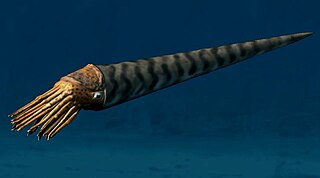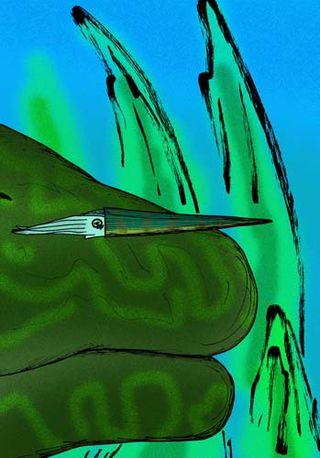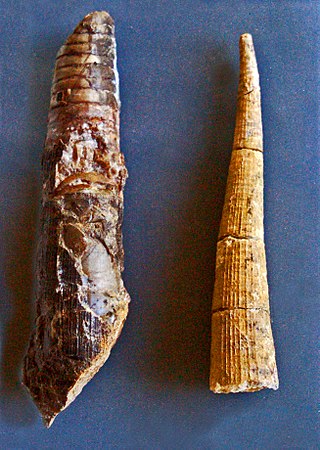
Orthoceras is a genus of extinct nautiloid cephalopod restricted to Middle Ordovician-aged marine limestones of the Baltic States and Sweden. This genus is sometimes called Orthoceratites. Note it is sometimes misspelled as Orthocera, Orthocerus or Orthoceros.

Lituites is an extinct nautiloid genus from the Middle Ordovician and type for the Lituitidae that in some more recent taxonomies has been classified with the orthocerids and listed under the order Lituitida. Fossils have been found in New York, Argentina, Norway, Sweden, Estonia, and China.

Orthoceratidae is an extinct family of actively mobile carnivorous cephalopods, subclass Nautiloidea, that lived in what would be North America, Europe, Asia, Africa, and Australia from the Ordovician through Triassic from 490—203.7 mya, existing for approximately 286.4 million years.
Cameroceras is an extinct genus of endocerid cephalopod which lived in equatorial oceans during the entire Ordovician period. Like other endocerids, it was an orthocone, meaning that its shell was fairly straight and pointed. It was particularly abundant and widespread in the Late Ordovician, inhabiting the shallow tropical seas in and around Laurentia, Baltica and Siberia.

The Ascocerida are comparatively small, bizarre Orthoceratoids known only from Ordovician and Silurian sediments in Europe and North America, uniquely characterized by a deciduous conch consisting of a longer juvenile portion and an inflated short adult portion that separate sometime in maturity.

Endoceras is an extinct genus of large, straight shelled cephalopods that gives its name to the Nautiloid order Endocerida. The genus lived during the middle and upper Ordovician 485 to 419 million years ago. The cross section in the mature portion is slightly wider than high, but is narrower laterally in the young. Sutures are straight and transverse. Endoceras has a large siphuncle, located close to the ventral margin, composed of concave segments, especially in the young but which may be tubular in the adult stage. Endocones are simple, subcircular in cross section, and penetrated by a narrow tube which may contain diaphragms reminiscent of the Ellesmerocerid ancestor.
Bathmoceras is a primitive cephalopod genus from the Middle and Upper Ordovician. It is a member of the order Cyrtocerinida and is the only genus in the family Bathmoceratidae.

Lamellorthoceratidae is a family of fossil orthoceratoids in the Orthocerida, defined by Curt Teichert in 1961. The lamellorthoceratids are placed in the superfamily Orthocerataceae in the Treatise on Invertebrate Paleontology.
The Reudemannoceratidae are the ancestral and most primitive of the Discosorida, an order of cephalopods from the early Paleozoic. The Reudemannoceratidae produced generally medium-sized endogastric and almost straight shells with the siphuncle slightly ventral from the center.
The Lowoceratidae is a small family of discosorids, early nautiloid cephalopods, from the Middle Silurian in which the characteristic bullette is found only in early growth stages. Lowoceratids were first found in Southampton Island in the Canadian arctic.

Kionoceras is an extinct nautiloid cephalopod genus included in the orthocerid family Kionoceratidae with scattered worldwide distribution from the Middle Ordovician to the Lower Permian. Kionoceratids are orthocerids with prominent longitudinal ornamentation on their shells, sometimes augmented by secondary transverse ornamentation. Orthocerids are, of course, prehistoric nautiloides with generally straight and elongate shells, mostly with central or subcentral siphuncles.
Brevicoceras is an extinct nautiloid genus from the order Oncocerida with wide distribution in the Middle Devonian in Eastern North America, Russia and Morocco. Nautiloids form a broad group of shelled cephalopods that were once diverse and numerous but are now represented by only a handful of species in two genera.
Winnipegoceras is an extinct nautiloid genus from the Ordovician belonging to the Order Discosorida.
Westonoceras is an extinct nautiloid genus from the Discosorida that lived during the Middle and Late Ordovician that has been found in North America, Greenland, and Northern Europe. It is the type genus for the Westonoceratidae

Orthoceratoidea is a major subclass of nautiloid cephalopods. Members of this subclass usually have orthoconic (straight) to slightly cyrtoconic (curved) shells, and central to subcentral siphuncles which may bear internal deposits. Orthoceratoids are also characterized by dorsomyarian muscle scars, extensive cameral deposits, and calciosiphonate connecting rings with a porous and calcitic inner layer.
Oonoceras is an extinct genus of fossil cephalopods included in the nautiloid order Oncocerida and the family Oncoceratidae from the Middle Ordovician to Middle Silurian of North America and Europe, arbitrarily included in the Slender Oncoceratidae.
Proterovaginoceras is a medium to large sized endocerid from the Early and Middle Ordovician included in the family Endoceratidae.
Simardoceras is a genus in the discosorid family Westonoceratidae from the Middle Ordovician of Quebec.
Albertoceras is a genus of Early Ordovician ellesmeroceratids with a small, slender, orthoconic to slightly endogastric shell; some even tiny. The cross section is strongly compressed so as to make the height proportionally notably greater than the width. The sutures, marking the edges of the septa, have broad, shallow, lateral lobes. The siphuncle, which seems to lack diaphragms, lies close to the venter.
Discosoridae comprise a family of endogastric discosorids, with endocones in the siphuncle, ranging from the Middle Silurian to Middle Devonian.






